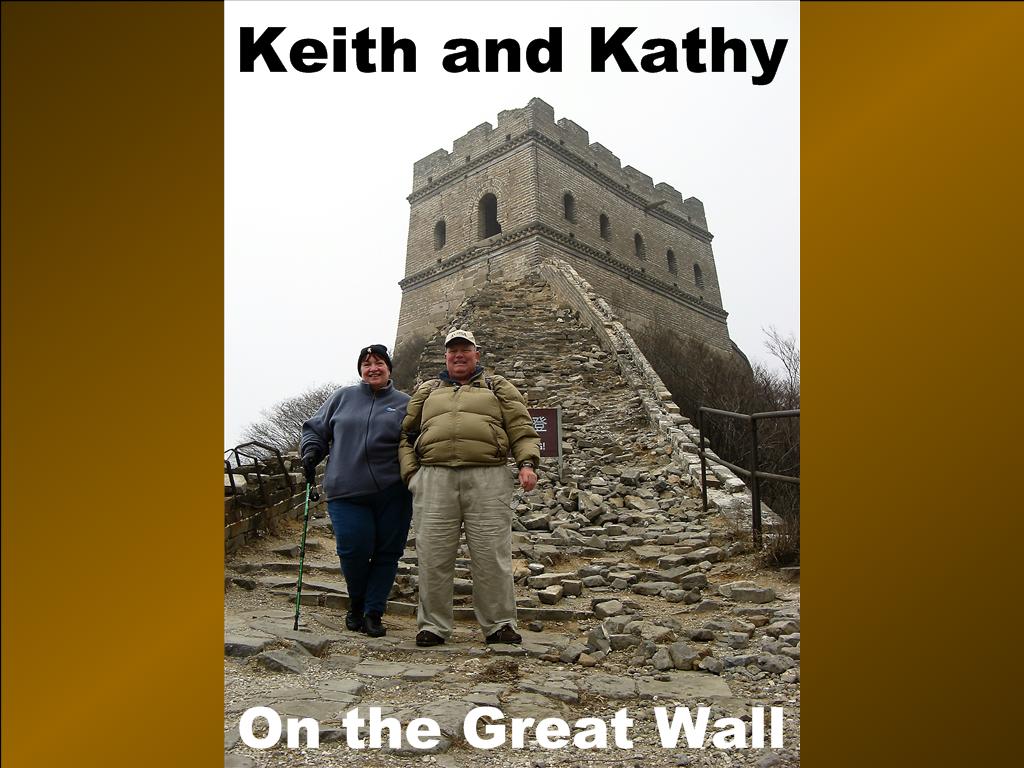Today is Confederation Day in Canada. Also known as Canada Day, it celebrates the anniversary of Canada’s original Confederation on July 1, 1867, in Charlottetown, PEI. On our way out of the campground this morning, our tail gunner met us, dressed for the occasion.

Bob and Marilyn, All Dressed Up for Confederation Day
Our drive today was the worst piece of road so far. We recall the stretch between Destruction Bay and Tok being not too bad in 2005. Today it is a mess. The further north we go, the deeper we penetrate into permafrost territory. Permafrost is soil that stays frozen permanently. Our Destruction Bay host told us that the permafrost under his campground is frozen to a depth of 160 feet. Only the top few feet thaw over the summer. Because the subsoil is frozen, water in the thawed layer can’t drain away, so the surface turns into muck every spring. The soldiers who built the pioneer road did not understand permafrost. They built the road and parked their machinery directly on the surface of the frozen ground. In late spring, the road turned to muck, and some of the machinery, including whole bulldozers, disappeared in the mud.
Another characteristic of permafrost is that the surface layer heaves and buckles as it freezes and thaws every year. This happens because water expands about ten percent when it freezes. That’s why frozen pipes burst, and why ice cubes are not flat, but have bumps in the center. Pavement also develops bumps as it freezes and thaws. These frost heaves can severely damage the road surface in only a few seasons. The truckers hate pavement in this country because of these frost heaves. On unpaved roads, it is easy to grade out the damage every spring, leaving a good driving surface for the trucks.
Building roads over permafrost requires a special technique. In the lower 48, road builders dig down to install a thick base of crushed stone, which is covered in turn by smaller stone, then pavement. In the arctic, an insulating layer is laid overtop of the soil, to prevent melting of the permafrost as the high emissivity road surface absorbs solar radiation. The road surface is laid down overtop of this insulating layer.
Driving over frost heaves at high speed is a recipe for disaster. In Canada, the road crews put out (very) small orange flags at most of the heaves, but these small flags are hard to see, especially in rain such as we had today. The best advance warning of frost heaves is wiggles in the white line, as shown below.
 The Wavy White Line Indicates Frost Heaves
The Wavy White Line Indicates Frost HeavesFrost heaves also affect anything sitting on or planted in the surface soil. In marshy areas, the trees stick up every which way as a result of being moved about in the freeze-thaw cycle. These are called drunken forests, for obvious reasons. Telephone poles are also susceptible to this type of damage. We wonder if conversations over these lines sound inebriated?
 An Example of a Drunken Forest
An Example of a Drunken Forest Drunken Telephone Poles
Drunken Telephone Poles We have spotted a surprising number of bicyclists on the Alcan. That’s got to be doing it the hard way. We don’t know if these folks stay in motels, but the distance between accommodations, combined with the large number which are out of business, have almost got to force these cyclists to sleep outdoors many places. We do not consider this a safe practice, because of bears.
 Traveling to Alaska the Hard Way
Traveling to Alaska the Hard Way No Room at the Inn for Weary Cyclists (Or Anybody Else)
No Room at the Inn for Weary Cyclists (Or Anybody Else)About halfway along our trek we crossed another border, passing from Canada into Alaska, again.
 A Lineup at the Border
A Lineup at the Border
Welcome to Alaska, Again
Shortly after entering Alaska, we were treated to a magnificent view of the Tanana River valley, with the Wrangell Mountains rising in the distance. Along the way we also spotted more pretty wildflowers.

Tanana River Valley

We arrived in Tok about 2pm, an hour ahead of the caravan-parking window. No problem! We bought fuel, then relaxed over lunch at Fast Eddies, one of our favorite restaurants in Alaska. Tomorrow is a free day, then on to Valdez for a few days. We are looking forward to the waterfront campground in Valdez.


No comments:
Post a Comment